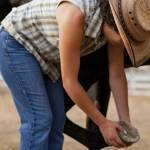Equine Veterinarians at Significant Risk for Injuries

Injuries are fairly common for anyone working around horses. Most horse owners have suffered bumps, bruises, stepped-on toes, and maybe an occasional fracture related to their equine activities, even though they typically spend only a few hours each day with their horses. It stands to reason that equine veterinarians, who interact with horses for many more hours, would have a higher rate of injuries, and this has been shown in the results of a survey commissioned by the British Equine Veterinary Association (BEVA).
When 620 equine veterinarians answered questions about injuries they had sustained in their work, results showed that these professionals had the highest risk of all civilian professionals. Their career-long rate of injury—seven or eight incidents that left them temporarily unable to work—was greater than for other high-risk jobs including fire fighters, construction workers, and prison guards.
Asked about their most serious injuries, veterinarians reported cuts, bruises, and fractures, with about one in four of these injuries requiring hospital admission. Horses kicking with a hind leg caused almost half of these injuries, with foreleg strikes and crush injuries causing 11 and 5%, respectively. Legs and heads were injured most often, and 7% of the injuries resulted in the veterinarian losing consciousness. Handlers and helpers were also injured, but at a much lower rate than veterinarians, who are often closest to the horse when procedures such as respiratory tract endoscopy and wound treatment are being conducted.
BEVA professionals will use the survey results to raise awareness of injury risks and seek ways to make veterinary work safer. A primary aim is to make safety a priority for practitioners, assistants, and horse handlers. Toward this goal, there may be incentives to use trained assistants and increase administration of sedatives while horses are being treated. BEVA is considering a cooperative effort with members, veterinary schools, and government agencies to develop policies and guidelines to increase safety and reduce injury risk within the profession.








